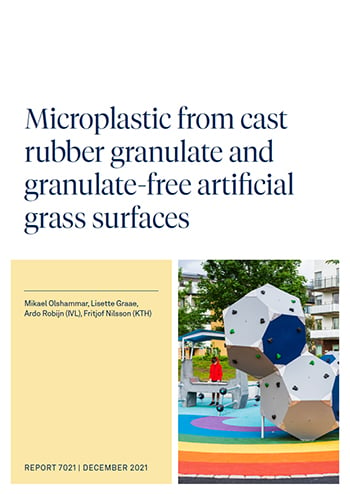Microplastic from cast rubber granulate and granulate-free artificial grass surfaces

About this report
This assignment focused on expanding knowledge about the dispersion of microplastics from cast rubber and granulate-free artificial grass surfaces by supplementing previous studies with new measurements and calculations. The goal was to improve estimates of how much these sources contribute to microplastics nationally and to identify strategies to better prevent leakage into the environment.
Based on the estimated rubber area on playgrounds and sports pitches nationally, combined with the measured microplastic emissions per year and square metre, total emissions from Sweden’s rubber surfaces are estimated to be about 16 tonnes/year. The equivalent estimate for artificial grass surfaces without granulates is about 2 tonnes/year. These are considerably smaller sources of emissions than sources such as; road traffic or artificial grass with infill, and in line with estimated microplastic emissions from fishing nets and other fishing implements. The relatively low values are attributable to the total area of these surfaces being significantly smaller compared with the total area of roads in Sweden. Microplastic emissions per m2 × year for surfaces with rubber granulate and granulate-free artificial grass were however almost on par with those from motorways, but lower than those from artificial grass with infill.
The project also developed technical specifications to limit the leakage of microplastics from surfaces with cast rubber granules. These include making good material choices, as well as considering the use of natural materials, which do not generate microplastics. Construction (environment, substrate and design) is another important aspect for reducing the leakage of microplastics from rubber surfaces and artificial grass surfaces, as is maintenance, which is crucial for a long lifespan and reduced leakage of microplastics from rubber materials. Always consider the use of natural materials, which do not generate microplastics, such as grass, wood chips or sand. Available cork products on the market have the same function and appearance as rubber materials. Construction (environment, substrate and design) is another important aspect for reducing the leakage of microplastics from rubber surfaces and artificial grass surfaces, as is maintenance, which is crucial for a long lifespan and reduced leakage of microplastics from rubber materials.
